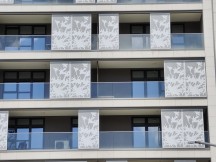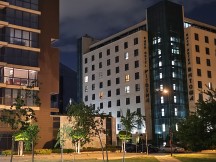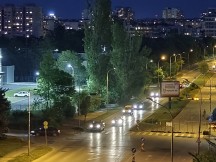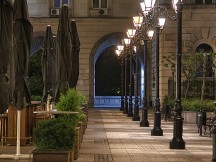vivo X80 Pro review

Daylight image quality
Coming from our past experience with high-end vivos, we weren't surprised to be treated to some great photos from the X80 Pro. Certain nuances did catch us somewhat off-guard, though. For one, we observed little to no difference between photos captured with the AI toggle Off, or On - at least in our test scenes we didn't witness what used to be a characteristic boost in contrast and color saturation.
Less surprising, ultimately, was the lack of much of a difference in the images taken in the Zeiss Natural color mode - that didn't prove to have a significant (or any) effect on the X70 Pro+ either. There's a twist to that statement, however, and it's in the fact that during shooting there appeared to be a clear distinction on the phone's screen when switching between the no AI regular photo mode and the Zeiss mode, a distinction that didn't translate into the resulting images. Hmm.

With that preamble behind us, let's look at some samples. Captured with AI off, these generally have a more restrained color rendition than previous vivo efforts which you could call an objectively good thing. While we won't hesitate to admit than punchier images are more to our taste, vivos were walking a fine line and dialing back the saturation a notch makes for a more accurate if slightly less dramatic output. Mind you, these aren't lifeless or anything, just... safer.
Dynamic range is great as ever and even deliberately shooting into the sun will net you well developed shadows and highlights, but also nicely high contrast.
There's little of note when it comes to detail - there's 12.5MP of it, as much as you'd get from competitors. It's also neither here nor there when it comes to character - more heavily processed examples exist, as do more organic renditions.












Daylight samples, main camera (1x)
A lot like last year, full-res 50MP shots have a different overall look, but this time it's not an odd color cast, but simply a lot more pop. Exposed brighter and with higher saturation, these look like what we'd expect from the AI-enhanced modes of before, but there's no AI toggle in 50MP mode. Some extra detail can be seen both in our studio shots and in certain real-life situations with... cooperating textures - the mural on the 'castle' wall isn't among them, but the balcony blinds in sample 4 and some of the foliage here and there doe have more definition.






Daylight samples, main camera (1x), 50MP
The 2x zoom camera's images can be a little grainy when viewed from up close, a bit more so than how we remember the ones from the X70 Pro+. The detail is still there, though. Couple that with the excellent dynamic range and the perfect color matching to the main camera (which wasn't strictly the case on the old model), and the X80 Pro's short telephoto is a winner. The gimbal didn't prove to have any effect on daylight stills, not that we'd really expect it to.






Daylight samples, telephoto camera (2x)
The 5x telephoto stays in line too in terms of color rendition. You can expect high-quality shots with sharp detail and very well contained noise.





Daylight samples, telephoto camera (5x)
Much like last year, the ultrawide camera's photos aren't exactly tack sharp, but they do still look good at 1:1 magnification and are among the better ones out there. Stop us if you've read this before, but these have likeable colors, if not quite with the usual vivo punch, and dynamic range is excellent.






Daylight samples, ultrawide camera (0.6x)
Here too, the nominal 48MP mode delivers that color punch we've come to expect from a vivo phone. The detail benefits are more questionable on the ultrawide than on the main camera, though you could use this mode for the colors, if that's your thing.






Daylight samples, ultrawide camera (0.6x), 48MP
Close-ups
The ultrawide camera on the X80 Pro, like on any self-respecting flagship, has autofocus, which means you can use it for shooting nearby subjects, be it for emphasizing perspective, or other creative pursuits.






Nearby subjects, ultrawide camera (0.6x)
There's also a macro mode which uses that same ultrawide camera but pulls up a center crop from the sensor and upscales it back to the 12MP number. The macro mode can be set to engage automatically, or you can force it on, but you can also disable that automatic behavior - a most appreciated option if you'd like to have the final say.
Macro mode will get you closer to your subjects and help fill the frame with tinier objects, but due to the nature of the process you'd end up will less than ideal per-pixel detail.
If you disengage Macro mode and shoot with the ultrawide in its native field of view, the images have less of a 'macro' look, but they are sharper.



Close-up samples, Macro mode off
For comparison, here's how that last one would look if captured on the main camera at its minimum focusing distance.
Low-light image quality
As we've come to expect, the X80 Pro applies some amount of Night mode processing in the regular photo mode without explicitly saying so. This behavior doesn't get in the way as the picture-taking process remains near-instant. It does it with the AI toggle disabled, while enabling it doesn't change much - all it does is morph into a shortcut for the actual Night mode when it's dark outside, without affecting the images, as best as we can tell.
The images produced in Photo mode from the main camera are properly great. We're getting well exposed shots with wide dynamic range and excellent development in the tonal extremes. Colors are a notch below in saturation compared to the X70 Pro+'s result, but still easily likeable and we observed no white balance mishaps. Detail is similarly excellent, albeit with a bit of that characteristic Night mode sharpening - not excessive, but not exactly natural. Noise is barely visible, even in the shadows.









Low-light samples, main camera (1x)
Night mode typically adds about a second to the capture time but it never really feels like it's making you wait for it. The differences are modest - we're seeing perhaps a little extra detail in the lower midtones, and a slight nudge in saturation with some warmer street lights, but it's hardly a dramatic improvement. Then again, there's no need for one - the regular photos were wonderful already.









Low-light samples, main camera (1x), Night mode
Night mode makes more of a noticeable difference at the 2x zoom level, specifically in terms of sharpness and detail in the darker areas. The slight saturation increase is there too. We'd prefer the results obtained that way, but the regular Photo mode shots (with a little implicit Night mode action) are very good too, only softer in the shadows. In any case, the 2x photos are top-class too.









Low-light samples, telephoto camera (2x)









Low-light samples, telephoto camera (2x), Night mode
The results aren't quite as solid at the 5x zoom level, particularly in darker scenes, where the 2x camera may stand in for the periscope, capturing noticeably soft images (samples 2 and 6). Where there's enough light for the real 5x to operate, the photos are noticeably better with reasonably well defined detail, though some noise too. Dynamic range is wide enough, you can possibly even call it excellent considering the small sensor, while colors maintain a solid level of saturation and fidelity.






Low-light samples, telephoto camera (5x)
Night mode is helpful most of the time, in terms of improving noise performance, but we wouldn't say it offers a substantial improvement.






Low-light samples, telephoto camera (5x), Night mode
Switching gears from the long tele to the ultrawide, the praiseworthy performance continues. There's usually little difference between Photo and Night mode, though certain scenes benefit more from the extra processing - compare the lower left corner of the second scene. Minor tonal improvements can be seen in direct before-after comparisons, but dynamic range is great either way and colors leave no grounds for complaint either.








Low-light samples, ultrawide camera (0.6x)








Low-light samples, ultrawide camera (0.6x), Night mode
Once you're done with the real world samples, head over to our Photo compare tool to see how the vivo X80 Pro stacks up against the competition.



vivo X80 Pro against the Xiaomi 12 Pro and the Galaxy S22 Ultra in our Photo compare tool
Portrait mode
There's a lot going on in the X80 Pro's Portrait mode. It offers you three magnifications - 1x, 2x, 5x, each sourced from the respective camera. Then there are styles and filters, four (and a half) Zeiss branded ones in the first category. Beautification enhancements are also at your disposal as well as guidelines for posing your subjects. Finally, you can control the level of bokeh to match a simulated aperture between f/0.95 and f/16, f/4.0 being the 'default'.
The 1x zoom level with its 23mm equivalent focal length means you must get pretty close to your subject for head-and-shoulders type of framing. Conversely, this being the main camera, you'd be looking at the best possible quality, particularly in low light.
As expected then, portraits shot at 1x have great detail on your subject, outdoors and in. We're getting excellent subject separation, and smoth background blur (though we did opt for f/2.0 instead of the default f/4.0). Dynamic range is nice and wide so even backlit scenes are a non-issue.
The 2x zoom level offers the best balance between subject distance and image quality. Only slightly behind the main camera in per-pixel detail, it doesn't disappoint when pixel peeping. Subject separation and blur characteristics are as good as on the main camera while the perspective of the 50mm-equivalent lens makes for much more flattering facial shapes.
If you're used to 1x portraits on smartphones, the 5x zoom level may feel like pushing you a bit too far from your subject, even tho 125mm is still within classic portrait focal length territory. The subject separation is still great in this mode and the perspective is very portrait-y, but detail quality is nowhere as good as on the other two.
The Zeiss lens simulation modes, found in the Styles section, aim to reproduce the characteristics of specific lens ranges by the German optics specialists. They're most noticeable in the way out-of-focus specular highlights are rendered, but also in the smoothness of the bokeh.




Portrait mode samples, 2x, Zeiss styles: Biotar • Sonnar • Planar • Distagon
Then there's the new Zeiss Cinematic style which captures images in a 2.39:1 ratio - that's not entirely well suited to stills, we reckon. We do like the oval bokeh balls made to recreate the look given by anamorphic cinema lenses.


Portrait mode samples, 2x, Zeiss Cinematic
Selfies
As before, you can only take selfies on the X80 Pro in the nominal 32MP resolution. While we'd be the first to admit that this is overkill for selfies, we do enjoy the ton of detail they offer. Colors are great too, and the only minor annoyance is the cautious approach to HDR in some scenes that may leave some highlights blown. There are no issues with overtly backlit scenes though - plenty of HDR for those (sample 3).
A welcome development on the X80 Pro is the consistent selfie portrait mode - on previous occasions, X70 Pro+ included, half the time it simply wouldn't work for no apparent reason, while here it won't let you down.
Subject isolation is good, with the occasional mishap not enough to ruin the positive impression. Naturally messier hair may expose its digital nature, but even that is handled rather well.
Reader comments
- Amitk
- 03 May 2025
- X%S
You can use Google Files app safe folder option to lock files
- dpak4u
- 10 Jul 2024
- Fnp
it is sad , you are not aware of 3.5 advantage , no battery no charging , plug and play works with most of all devices
- Arijit Jhampri
- 28 Jul 2023
- P@L
The only concerning thing in funtouch is that it lacks a password protected app lock or a private safe.


























